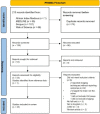Retinal imaging technologies in cerebral malaria: a systematic review
- PMID: 37101295
- PMCID: PMC10131356
- DOI: 10.1186/s12936-023-04566-7
Retinal imaging technologies in cerebral malaria: a systematic review
Abstract
Background: Cerebral malaria (CM) continues to present a major health challenge, particularly in sub-Saharan Africa. CM is associated with a characteristic malarial retinopathy (MR) with diagnostic and prognostic significance. Advances in retinal imaging have allowed researchers to better characterize the changes seen in MR and to make inferences about the pathophysiology of the disease. The study aimed to explore the role of retinal imaging in diagnosis and prognostication in CM; establish insights into pathophysiology of CM from retinal imaging; establish future research directions.
Methods: The literature was systematically reviewed using the African Index Medicus, MEDLINE, Scopus and Web of Science databases. A total of 35 full texts were included in the final analysis. The descriptive nature of the included studies and heterogeneity precluded meta-analysis.
Results: Available research clearly shows retinal imaging is useful both as a clinical tool for the assessment of CM and as a scientific instrument to aid the understanding of the condition. Modalities which can be performed at the bedside, such as fundus photography and optical coherence tomography, are best positioned to take advantage of artificial intelligence-assisted image analysis, unlocking the clinical potential of retinal imaging for real-time diagnosis in low-resource environments where extensively trained clinicians may be few in number, and for guiding adjunctive therapies as they develop.
Conclusions: Further research into retinal imaging technologies in CM is justified. In particular, co-ordinated interdisciplinary work shows promise in unpicking the pathophysiology of a complex disease.
Keywords: Cerebral malaria; Fluorescein angiography; Fundus photography; Malarial retinopathy; Optical coherence tomography.
© 2023. The Author(s).
Conflict of interest statement
The authors declare that they have no competing interests.
Figures





Similar articles
-
Optical coherence tomography (OCT) for detection of macular oedema in patients with diabetic retinopathy.Cochrane Database Syst Rev. 2011 Jul 6;(7):CD008081. doi: 10.1002/14651858.CD008081.pub2. Cochrane Database Syst Rev. 2011. Update in: Cochrane Database Syst Rev. 2015 Jan 07;1:CD008081. doi: 10.1002/14651858.CD008081.pub3. PMID: 21735421 Updated.
-
Magnetic resonance perfusion for differentiating low-grade from high-grade gliomas at first presentation.Cochrane Database Syst Rev. 2018 Jan 22;1(1):CD011551. doi: 10.1002/14651858.CD011551.pub2. Cochrane Database Syst Rev. 2018. PMID: 29357120 Free PMC article.
-
Signs and symptoms to determine if a patient presenting in primary care or hospital outpatient settings has COVID-19.Cochrane Database Syst Rev. 2022 May 20;5(5):CD013665. doi: 10.1002/14651858.CD013665.pub3. Cochrane Database Syst Rev. 2022. PMID: 35593186 Free PMC article.
-
Home treatment for mental health problems: a systematic review.Health Technol Assess. 2001;5(15):1-139. doi: 10.3310/hta5150. Health Technol Assess. 2001. PMID: 11532236
-
A rapid and systematic review of the clinical effectiveness and cost-effectiveness of topotecan for ovarian cancer.Health Technol Assess. 2001;5(28):1-110. doi: 10.3310/hta5280. Health Technol Assess. 2001. PMID: 11701100
Cited by
-
Type II Acute Macular Neuroretinopathy Secondary to Malaria.Case Rep Ophthalmol Med. 2024 May 29;2024:1577127. doi: 10.1155/2024/1577127. eCollection 2024. Case Rep Ophthalmol Med. 2024. PMID: 38938742 Free PMC article.
-
Is there a role for bradykinin in cerebral malaria pathogenesis?Front Cell Infect Microbiol. 2023 Aug 10;13:1184896. doi: 10.3389/fcimb.2023.1184896. eCollection 2023. Front Cell Infect Microbiol. 2023. PMID: 37637466 Free PMC article. Review.
-
Smartphone conjunctiva photography for malaria risk stratification in asymptomatic school age children.NPJ Digit Med. 2025 Mar 10;8(1):151. doi: 10.1038/s41746-025-01548-8. NPJ Digit Med. 2025. PMID: 40065117 Free PMC article.
References
-
- WHO . World malaria report. Geneva: World Health Organization; 2021.
-
- WHO . Guidelines for malaria. Geneva: World Health Organization; 2022.
Publication types
MeSH terms
LinkOut - more resources
Full Text Sources
Medical

